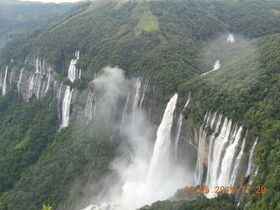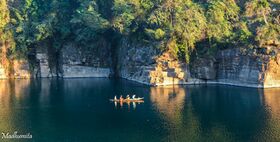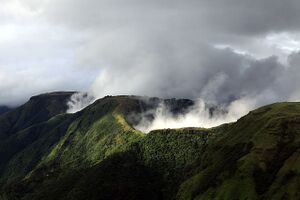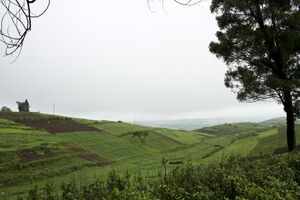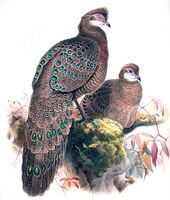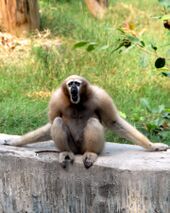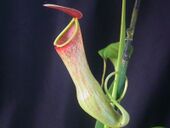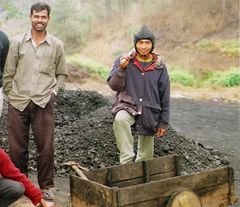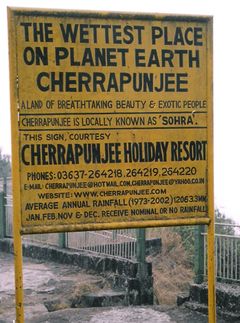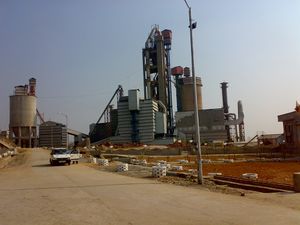مگهاليا
Meghalaya | |||||||||||||||||||
|---|---|---|---|---|---|---|---|---|---|---|---|---|---|---|---|---|---|---|---|
Clockwise from top: Nohkalikai Falls, Tawny Breasted Wren, Umngot River, Khrangsuri waterfall | |||||||||||||||||||
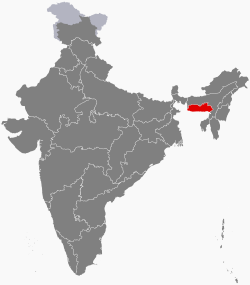 | |||||||||||||||||||
| الإحداثيات (Shillong): 25°34′N 91°53′E / 25.57°N 91.88°E | |||||||||||||||||||
| البلد | |||||||||||||||||||
| التشكل | 21 يناير 1972[2] | ||||||||||||||||||
| العاصمة | شيلونگ | ||||||||||||||||||
| أكبر مدينة | شيلونگ | ||||||||||||||||||
| الأضلع | 11 | ||||||||||||||||||
| الحكومة | |||||||||||||||||||
| • الحاكم | Banwarilal Purohit | ||||||||||||||||||
| • Chief Minister | Mukul Sangma (INC) | ||||||||||||||||||
| • Legislature | أحادي الغرفة (60 مقعد) | ||||||||||||||||||
| • Parliamentary constituency | راجيا سابها 1 Lok Sabha 2 | ||||||||||||||||||
| • High Court | Meghalaya High Court | ||||||||||||||||||
| المساحة | |||||||||||||||||||
| • الإجمالي | 22٬429 كم² (8٬660 ميل²) | ||||||||||||||||||
| ترتيب المساحة | 23rd | ||||||||||||||||||
| التعداد (2016) | |||||||||||||||||||
| • الإجمالي | 3٬211٬000 | ||||||||||||||||||
| • الترتيب | 23rd[1] | ||||||||||||||||||
| • الكثافة | 140/km2 (370/sq mi) | ||||||||||||||||||
| منطقة التوقيت | UTC+05:30 (IST) | ||||||||||||||||||
| ISO 3166 code | IN-ML | ||||||||||||||||||
| HDI | ▲ 0.585 (medium) | ||||||||||||||||||
| HDI rank | 19th (2005) | ||||||||||||||||||
| Literacy | 75.84% (24th)[1] | ||||||||||||||||||
| Official language | English[2] | ||||||||||||||||||
| الموقع الإلكتروني | meghalaya | ||||||||||||||||||
| |||||||||||||||||||
| [3] It received the status of a full-fledged State in 1971 by the North-Eastern Areas (Reorganisation) Act, 1971 | |||||||||||||||||||
مگهاليا (Meghalaya ؛ /meɪɡˈɑːləjə/[3] or US: /ˌmeɪɡəˈleɪə/;[4] /meːɡʱaːləj(ə)/[بحاجة لمصدر] ؛ وتعني السنسكريتية: "معقل السحاب") ولاية صغيرة تقع شمال شرق الهند، تبلغ مساحتها 22,429 كم². يبلغ عدد سكانها 3,211,000 نسمة حسب إحصاء عام 2016. وعاصمتها مدينة شيلونگ. ويزاول سكانها زراعة الفواكه والخضراوات والحبوب. والولاية غنية بخامات المعادن التي لم تستغل بعد، وتعتمد في اقتصادها على الصناعات اليدوية وصناعة النسيج ولا توجد بها صناعات حديثة.
الولاية يحدها من الجنوب القسمان البنگلادشيان ميمنسنغ وسلهط، ومن الغرب القسم البنگلادشي رانگپور، ومن الشمال والشرق ولاية أسام الهندية. عاصمة مگهاليا هي شيلونگ. وأثناء الحكم البريطاني للهند، أطلقت السلطات الإمبريالية البريطانية على مگهاليا كنية "اسكتلندا الشرق".[5] مگهاليا كانت في السابق جزء من أسام، ولكن في 21 يناير 1972، أضلع خاسي و هضاب گارو و جاينتيا أصبحت تشكل الولاية الجديدة، مگهاليا. الإنجليزية هي اللغة الرسمية لمگهاليا. اللغات الرئيسية الأخرى المستخدمة تضم Khasi, Pnar, Hajong, Rabha, Garo and Biate. وعلى العكس من العديد من الولايات الهندية، فإن مگهاليا، على مر التاريخ، إتبعت نظاماً matrilineal، حيث النسب والإرث يكون عبر الأم؛ فأضغر البنات ترث كل الثروة، كما أنها ترعى أبويها.[5]
الولاية هي أكثر المناطق هطولاً للأمطار في الهند، بمتوسط 12,000 مم من الأمطار سنوياً.[6] ونحو 70% من الولاية يغطيه الغابات.[7] المنطقة البيئية غابات مگهاليا دون المدارية تكتنف الولاية؛ وغاباتها الجبلية تتميز عن الغابات المدارية في المنخفضات إلى الشمال والجنوب. الغابات تتميز تنوعها الحيوي في الثدييات والطيور والنباتات.
مگهاليا هي في معظمها اقتصاد زراعي ومعه صناعة غابات تجارية بارزة. المحاصيل الهامة هي البطاطس والأرز والذرة والأناناس والموز والپاپايا والتوابل، إلخ. The service sector is made up of real estate and insurance companies. الناتج المحلي الإجمالي لمگهاليا لعام 2012 قـُدِّر بقيمة ₹16٬173 crore (2�0 بليون US$) بالأسعار الحالية.[8] الولاية غنية جيولوجياً بالمعادن، إلا أنها لم تبدأ في استغلالها بعد.[5] تضم الولاية نحو 1,170 كم من الطرق السريعة الوطنية. كما أنها مركزاً لوجستياً للتجارة مع بنگلادش.[6]
التاريخ
- القديم
مگهاليا مع جاراتها من الولايات الهندية، حظين باهتمام أثري. People have lived in Meghalaya since the Neolithic. Neolithic sites discovered so far are located in areas of high elevation in Khasi Hills, Garo Hills and in neighbouring states, where Neolithic style jhum or shifting cultivation is practised even today. The highland plateaus fed by abundant rains provided safety from floods and a rich soil.[9] The importance of Meghalaya is its possible role in human history via domestication of rice. One of the competing theories for the origin of rice comes from Ian Glover, who states, "India is the center of greatest diversity of domesticated rice with over 20,000 identified species and Northeast India is the most favorable single area of the origin of domesticated rice."[10] The limited archaeology done in the hills of Meghalaya suggest human settlement since ancient times.[11]
After the Conquest of Taraf in 1304, Shah Arifin Rafiuddin, a disciple of Shah Jalal, migrated and settled in the Khasi and Jaintia Hills where he preached Islam to the local people. His khanqah remains in Sarping/Laurergarh on the Bangladeshi border but the part containing his mazar is in Meghalaya on top of Laur Hill.[12]
Bhaitbari is an archaeological site first discovered and excavated by A. K. Sharma in 1993, a fortification of burnt brick with mud core was discovered at Meghalaya - Assam border and is dated to 4th-8th century AD, the city has been speculated to have been one of the capital cities of Kamarupa.[13]
التاريخ الحديث
The British discovery of Camellia sinensis in 1834 in Assam and later companies to renting land from 1839 onwards.[14][مطلوب توضيح]
The Khasi, Garo, and Jaintia tribes had their own kingdoms until they came under British administration in the 19th century. Later, the British incorporated Meghalaya into Assam in 1835.[5] The region enjoyed semi-independent status by virtue of a treaty relationship with the British Crown. When Bengal was partitioned on 16 October 1905 by Lord Curzon, Meghalaya became a part of the new province of Eastern Bengal and Assam. However, when the partition was reversed in 1912, Meghalaya became a part of the province of Assam. On 3 January 1921 in pursuance of Section 52A of the Government of India Act of 1919, the governor-general-in-council declared the areas now in Meghalaya, other than the Khasi states, as "backward tracts." Subsequently, the British administration enacted the Government of India Act 1935, which regrouped the backward tracts into two categories: "excluded" and "partially excluded" areas.
At the time of Indian independence in 1947, present-day Meghalaya constituted two districts of Assam and enjoyed limited autonomy within the state of Assam. A movement for a separate Hill State began in 1960.[15] On 11 September 1968 the Government of India announced a scheme for constituting an autonomous state within the state of Assam comprising certain areas specified in Part A of the table appended to paragraph 20 of the Sixth Schedule to the Constitution.[16] Accordingly, the Assam Reorganisation (Meghalaya) Act of 1969 was enacted for the formation of an autonomous state.[17] Meghalaya was formed by carving out two districts from the state of Assam: the United Khasi Hills and Jaintia Hills, and the Garo Hills.[15] The name 'Meghalaya' coined by geographer S.P. Chatterjee in 1936 was proposed and accepted for the new state.[18][19] The Act came into effect on 2 April 1970, with the autonomous state having a 37-member legislature in accordance with the Sixth Schedule to the Indian constitution.
In 1971, the Parliament passed the North-Eastern Areas (Reorganisation) Act, 1971, which conferred full statehood on the autonomous state of Meghalaya. Meghalaya attained statehood on 21 January 1972, with a Legislative Assembly of its own.[15]
الجغرافيا
Meghalaya is one of the Seven Sister States of northeast India. The state of Meghalaya is mountainous, with stretches of valley and highland plateaus, and it is geologically rich. It consists mainly of Archean rock formations. These rock formations contain rich deposits of valuable minerals like coal, limestone, uranium and sillimanite.
Meghalaya has many rivers. Most of these are rainfed and seasonal. The important rivers in the Garo Hills region are Ganol, Daring, Sanda, Bandra, Bugai, Dareng, Simsang, Nitai and the Bhupai. In the central and eastern sections of the plateau, the important rivers are Khri, Umtrew, Digaru, Umiam or Barapani, Kynshi (Jadukata), Umngi, Mawpa, Umiam Khwan, Umngot, Umkhen, Myntdu and Myntang. In the southern Khasi Hills region, these rivers have created deep gorges and several waterfalls.
The elevation of the plateau ranges between 150 m (490 ft) to 1،961 m (6،434 ft). The central part of the plateau comprising the Khasi Hills has the highest elevations, followed by the eastern section comprising the Jaintia Hills region. The highest point in Meghalaya is Shillong Peak, which is a prominent IAF station in the Khasi Hills overlooking the city of Shillong. It has an altitude of 1961 m. The Garo Hills region in the western section of the plateau is nearly plain. The highest point in the Garo Hills is Nokrek Peak with an altitude of 1515 m.
المناخ
With average annual rainfall as high as 12،000 mm (470 in) in some areas, Meghalaya is the wettest place on earth.[20] The western part of the plateau, comprising the Garo Hills region with lower elevations, experiences high temperatures for most of the year. The Shillong area, with the highest elevations, experiences generally low temperatures. The maximum temperature in this region rarely goes beyond 28 °C (82 °F),[21] whereas sub-zero winter temperatures are common.
The town of Sohra (Cherrapunji) in the Khasi Hills south of capital Shillong holds the world record for most rain in a calendar month, while the village of Mawsynram, near Sohra (Cherrapunji), holds the record for the most rain in a year.[22][23]
النبيت والوحيش
About 70% of the state is forested, of which 9،496 km2 (3،666 sq mi) is dense primary subtropical forest.[7] The Meghalayan forests are considered to be among the richest botanical habitats of Asia. These forests receive abundant rainfall and support a vast variety of floral and faunal biodiversity. A small portion of the forest area in Meghalaya is under what are known as "sacred groves" (see Sacred groves of India). These are small pockets of an ancient forest that have been preserved by the communities for hundreds of years due to religious and cultural beliefs. These forests are reserved for religious rituals and generally remain protected from any exploitation. These sacred groves harbour many rare plant and animal species. The Nokrek Biosphere Reserve in the West Garo Hills and the Balphakram National Park in the South Garo Hills are considered to be the most biodiversity-rich sites in Meghalaya.[بحاجة لمصدر] In addition, Meghalaya has three wildlife sanctuaries. These are the Nongkhyllem Wildlife Sanctuary, the Siju Sanctuary, and the Baghmara Sanctuary, which is also the home of the insect-eating pitcher plant Nepenthes khasiana also called "Me'mang Koksi" in the Garo language.
Due to diverse climatic and topographic conditions, Meghalaya forests support a vast floral diversity, including a large variety of parasites, epiphytes, succulent plants and shrubs. Two of the most important tree varieties are Shorea robusta (sal tree) and Tectona grandis (teak). Meghalaya is also the home to a large variety of fruits, vegetables, spices, and medicinal plants. Meghalaya is also famous for its large variety of orchids — nearly 325 of them. Of these, the largest variety is found in the Mawsmai, Mawmluh and Sohrarim forests in the Khasi hills.
Meghalaya also has a large variety of mammals, birds, reptiles and insects.[26] The important mammal species include elephants, bear, red pandas,[27] small Indian civets, mongooses, weasels, rodents, gaur, wild buffalo,[28] deer, wild boar and a number of primates. Meghalaya also has a large variety of bats. The limestone caves in Meghalaya such as the Siju Cave are home to some of the nation's rarest bat species. The hoolock gibbon is found in all districts of Meghalaya.[29]
Common reptiles in Meghalaya are lizards, crocodiles and tortoises. Meghalaya also has a number of snakes including the python, copperhead, green tree racer, Indian cobra, king cobra, coral snake and vipers.[30]
Meghalaya's forests host 660 species of birds, many of which are endemic to Himalayan foothills, Tibet and Southeast Asia. Of the birds found in Meghalaya forests, 34 are on worldwide threatened species list and 9 are on the critically endangered list.[24] Prominent birds spotted in Meghalaya include those from the families of Phasianidae, Anatidae, Podicipedidae, Ciconiidae, Threskiornithidae, Ardeidae, Pelecanidae, Phalacrocoracidae, Anhingidae, Falconidae, Accipitridae, Otididae, Rallidae, Heliornithidae, Gruidae, Turnicidae, Burhinidae, Charadriidae, Glareolidae, Scolopacidae, Jacanidae, Columbidae, Psittacidae, Cuculidae, Strigidae, Caprimulgidae, Apodidae, Alcedinidae, Bucerotidae, Ramphastidae, Picidae, Campephagidae, Dicruridae, Corvidae, Hirundinidae, Cisticolidae, Pycnonotidae, Sylviidae, Timaliidae, Sittidae, Sturnidae, Turdidae, Nectariniidae and Muscicapidae.[24] Each of these families have many species. The great Indian hornbill is the largest bird in Meghalaya. Other regional birds found include the grey peacock pheasant, the large Indian parakeet and the common green pigeon.[31] Meghalaya is also home to over 250 species of butterflies, nearly a quarter of all butterfly species found in India.
In 2020, scientists have discovered the largest known subterranean fish in Meghalaya's Jaintia Hills.[32]
الديمغرافيا
Population
| Population Growth | |||
|---|---|---|---|
| Census | Pop. | %± | |
| 1951 | 606٬000 | ||
| 1961 | 769٬000 | 26.9% | |
| 1971 | 1٬012٬000 | 31.6% | |
| 1981 | 1٬336٬000 | 32.0% | |
| 1991 | 1٬775٬000 | 32.9% | |
| 2001 | 2٬319٬000 | 30.6% | |
| 2011 | 2٬964٬007 | 27.8% | |
| Source: Census of India[33] | |||
- Ethnic groups 2011:[بحاجة لمصدر]
Tribal people make up the majority of Meghalaya's population. The Khasis are the largest group, followed by the Garos then the Jaintias. These were among those known to the British as "hill tribes." Other groups include the Bengali, Hajongs, the Biates, the Koches and related Rajbongshis, the Boros, Dimasa, Kuki, Lakhar, Tiwa (Lalung), Karbi, Rabha and Nepali.
Meghalaya recorded the highest decennial population growth of 27.82% among all the seven north-eastern states, as per the provisional report of census 2011. The population of Meghalaya as of 2011 has been estimated at 2,964,007 of which females constitute 1,492,668 and males 1,471,339. As per the census of India 2011, the sex ratio in the state was 986 females per 1,000 males which was far higher than the national average of 940. The urban female sex ratio of 985 was higher than the rural sex ratio of 972.[1]
الدين
Meghalaya is one of three states in India to have a Christian majority. About 75% of the population practices Christianity, with Presbyterians, Baptists and Catholics the more common denominations.[34] The religion of the people in Meghalaya is closely related to their ethnicity. Close to 90% of the Garo tribe and nearly 80% of the Khasi are Christian, while more than 97% of the Hajong, 98.53% of the Koch, and 94.60% of the Rabha tribes are Hindu.[بحاجة لمصدر]
Hindus are the largest religious minority in Meghalaya with 11.52% of the total state's population as of 2011 census[34] Hindus are concentrated mainly in West Garo Hills, East Khasi Hills and Ri-Bhoi with 19.11 per cent, 17.55 per cent and 11.96 per cent respectively. The Nartiang Durga Temple is a major Hindu temple in Meghalaya and it is one of the 51 Shakti peethas on Earth.[35]
Muslims constitute 4.39% of the population[34] The Muslims are concentrated mainly in West Garo Hills with 16.60 per cent.[36]
Conversion from indigenous to Christianity began in the 19th century during the British colonial era. In the 1830s, American Baptist Foreign Missionary Society had become active in Northeast India to convert indigenous tribes to Christianity.[37] Later, they were offered to expand and reach into Cherrapunji Meghalaya, but they declined out of the lack of resources. Taking up the offer, the Welsh Presbyterian Mission began work at the Cherrapunji mission field. By the early 1900s, other Protestant denominations of Christianity were active in Meghalaya. The outbreak of World Wars forced the preachers to return home to Europe and America. It is during this period that Catholicism took root in Meghalaya and neighbouring regions. In the 20th century, Union Christian College started operations at Barapani, Shillong. Currently, Presbyterians and Catholics are two most common Christian denominations found in Meghalaya.[38]
Languages
English is the official language of the state.[40] The most spoken languages in Meghalaya are Khasi (33.82%) and Garo (31.60%) followed by Pnar (10.69%), Bengali (6.44%), Nepali (1.85%), War (1.73%), Hindi (1.62%), Hajong (1.40%) and Assamese (1.34%).[39]
Khasi (also spelled Khasia, Khassee, Cossyah, and Kyi) is a branch of the Mon–Khmer family of the Austroasiatic stock and according to 2001 census, Khasi is spoken by about 1,128,575 people residing in Meghalaya. Many words in the Khasi language have been borrowed from Indo-Aryan languages such as Assamese, Bengali and Nepali. Moreover, the Khasi language originally had no script of its own. The Khasi language is one of the very few surviving Mon–Khmer languages in India today.
The Garo language has a close affinity with the Koch and Bodo languages, a small family of Tibeto-Burman languages. Garo, spoken by the majority of the population, is spoken in many dialects such as Abeng or Ambeng,[41] Atong, Akawe (or Awe), Matchi Dual, Chibok, Chisak Megam or Lyngngam, Ruga, Gara-Ganching and Matabeng.
Pnar is spoken by many people of the both West and East Jaintia Hills. The language is related to the Khasi language. Apart from the main languages, various local dialect are being spoken by the War Jaintia (West Jaintia Hills), Maram and Lynngam (West Khasi Hills), War Pynursla (East Khasi Hills), Tiwa language by Tiwa peoples of Ri-Bhoi district. Another example is the Biate language spoken by many people inhabiting the south-eastern part of Meghalaya bordering Assam.
Indo-Aryan languages like Hajong, Assamese, Bengali, Nepali and Hindi are spoken by many people residing mostly in the East Khasi Hills district and the West Garo Hills district.
English is spoken as a common language across the diverse ethnic and demographic groups. In urban centres most of the people can speak English; rural residents vary in their ability.
مگهاليا ضمن المحافظات الشرقية التي تسيطر عليها غالبية مسيحية من أعراق صينية ومالاوية, - مسيحية 75% - هندوس 11% - مسلمين 5% محاولات الهندوس المتطرفين طرد المسلمين من شرق الهند هي محاولات مستحيلة إذ أن الغالبية المسيحية ترفض الحكم الهندوسي ولهم محاولات كثيرة في الإنفصال عن الهند, غير ذلك مسيحيو شرق الهند يأكلون لحم البقر ويمارسون تعدد الزوجات ودينهم أقرب للبروتستانتية غير مسيحي الغرب الذين هم أقرب للكاثوليكية, ولذا فإن أي تطرف وعنصرية هندوسية في الشرق هي يائسة, والعرقيات في شرق الهند تميل لأعراق الصين والأعراق الأوسترونيسية ...
المراكز
المناخ
الاقتصاد
This is a chart of trends in the gross state domestic product of Meghalaya at market prices estimated by Ministry of Statistics and Programme Implementation with figures in millions of Indian Rupees.
| السنة | الناتج المحلي الإجمالي للولاية |
|---|---|
| 1980 | 2,000 |
| 1985 | 3,930 |
| 1990 | 8,900 |
| 1995 | 19,950 |
| 2000 | 37,280 |
حقائق وأرقام
الهامش
- ^ أ ب ت "List of states with Population, Sex Ratio and Literacy Census 2011". Census2011.co.in. Retrieved 2012-11-09.
- ^ "Report of the Commissioner for linguistic minorities: 47th report (July 2008 to June 2010)" (PDF). Commissioner for Linguistic Minorities, Ministry of Minority Affairs, Government of India. pp. 84–89. Archived from the original (PDF) on 13 May 2012. Retrieved 16 February 2012.
- ^ "Definition of Meghalaya in English from the Oxford Dictionary". Oxford Dictionary. Retrieved 1 April 2015.
- ^ "Meghalaya | Define Meghalaya at Dictionary.com". Dictionary.reference.com. 2014-07-14. Retrieved 2017-02-27.
- ^ أ ب ت ث Arnold P. Kaminsky and Roger D. Long (2011), India Today: An Encyclopedia of Life in the Republic, ISBN 978-0313374623, pp. 455-459
- ^ أ ب خطأ استشهاد: وسم
<ref>غير صحيح؛ لا نص تم توفيره للمراجع المسماةibef - ^ أ ب Meghalaya and Its Forests Government of Meghalaya (2012); Quote – total forest area is 69.5%
- ^ خطأ استشهاد: وسم
<ref>غير صحيح؛ لا نص تم توفيره للمراجع المسماةpcindia - ^ Hazarika, Manjil (2006). "Neolithic Culture of Northeast India: A Recent Perspective on the Origins of Pottery and Agriculture". Ancient Asia. 1: 25–44. doi:10.5334/aa.06104.
- ^ Glover, Ian C. (1985), Some Problem Relating to the Domestication of Rice in Asia, In Recent Advances in Indo-Pacific Prehistory (Misra, VN. and P. Bellwood Eds.), ISBN 978-8120400153, Oxford Publishing, pp 265-274
- ^ SANKAR KUMAR ROY, Aspects of Neolithic Agriculture and Shifting Cultivation, Garo Hills, Meghalaya, Asian Perspectives, XXIV (2), 1981, pp 193-221
- ^ "Upazila background". Tahirpur Upazila.
- ^ "Archaeology: Department of Arts and Culture, Government of Meghalaya". megartsculture.gov.in. Retrieved 2021-08-14.
- ^ Roy, Tirthankar (2012). India in the World Economy: From Antiquity to the Present. Cambridge University Press. p. 202. ISBN 978-1-107-00910-3.
- ^ أ ب ت خطأ استشهاد: وسم
<ref>غير صحيح؛ لا نص تم توفيره للمراجع المسماةmeghis - ^ "High Court of Meghalaya: History". Retrieved 23 December 2020.
- ^ "The Assam Reorganisation (Meghalaya) Act, 1969" (PDF). Retrieved 23 December 2020.
- ^ Bareh, H.M. (2001). Encyclopaedia of North-East India: Vol IV. Mittal Publications. ISBN 81-7099-791-7.
- ^ "Press Releases: Lecture on Emerging Challenges in Mapping". Retrieved 23 December 2020.
- ^ Ammu Kannampilly (31 July 2013). "The Wettest Place On Earth: Indian Town Of Mawsynram Holds Guinness Record For Highest Average Annual Rainfall". Huffington Post. Archived from the original on 23 August 2013. Retrieved 16 August 2013.
- ^ "Basic facts of Meghalaya". Archived from the original on 20 يناير 2012. Retrieved 13 يناير 2012.
- ^ Kuttippurath, J; Murasingh, S; Stott, P A; Sarojini, B Balan; Jha, Madan K; Kumar, P; Nair, P J; Varikoden, H; Raj, S; Francis, P A; Pandey, P C (2021-01-22). "Observed rainfall changes in the past century (1901–2019) over the wettest place on Earth". Environmental Research Letters. 16 (2): 024018. doi:10.1088/1748-9326/abcf78. ISSN 1748-9326.
- ^ "Global Weather & Climate Extremes". World Meteorological Organisation. Archived from the original on 13 December 2013. Retrieved 25 September 2010.
- ^ أ ب ت Birds of Meghalaya Archived 22 يناير 2015 at the Wayback Machine Avibase (2013)
- ^ Wildlife in Meghalaya Archived 1 مارس 2014 at the Wayback Machine Government of Meghalaya
- ^ Choudhury, A. U. (2003) "Meghalaya's vanishing wilderness". Sanctuary Asia 23(5): 30–35
- ^ Choudhury, A. U. (1996) "Red panda in Garo Hills". Environ IV(I): 21
- ^ Choudhury, A. U. (2010) The Vanishing Herds: the wild water buffalo. Gibbon Books, Rhino Foundation, CEPF & COA, Taiwan, Guwahati, India
- ^ Choudhury, A. U. (2006) "The distribution and status of hoolock gibbon, Hoolock hoolock, in Manipur, Meghalaya, Mizoram and Nagaland in Northeast India". Primate Conservation 20: 79–87
- ^ Zoological Survey of India, Fauna of Meghalaya: Vertebrates, Part 1 of Fauna of Meghalaya, Issue 4, Government of India (1995)
- ^ Choudhury, A.U. (1998) Birds of Nongkhyllem Wildlife Sanctuary & adjacent areas. The Rhino Foundation for Nature in North East India, Guwahati, India. 31pp.
- ^ "World's largest cave fish discovered in India". Animals (in الإنجليزية). 12 February 2020. Retrieved 29 March 2020.
- ^ "Census Population" (PDF). Census of India. Ministry of Finance India. Archived from the original (PDF) on 12 أغسطس 2011. Retrieved 18 ديسمبر 2008.
- ^ أ ب ت ث "Population by religion community – 2011". Census of India, 2011. The Registrar General & Census Commissioner, India. Archived from the original on 25 August 2015.
- ^ Das, Manosh (15 October 2010). "Lofty Himalayas notwithstanding, the tribal people of Nartiang in the Jaintia Hills of Meghalaya truly believe that their scenic little hamlet is the "permanent abode" of Goddess Durga. Perched atop a hillock is the more than 600-year old and ancient Durgabari - a simple house made of stones and wood complete with tin roofing. Revered as one of the 51 Shakti Peethas, the temple has been drawing a large number of pilgrims from all over the country on occasion of Durga Puja. - Times of India". The Times of India. Retrieved 20 December 2019.
- ^ [1]
- ^ Johnson, R. E. (2010). A Global Introduction to Baptist Churches. Cambridge University Press. ISBN 978-0521877817.
- ^ Amrit Kumar Goldsmith, The Christians In The North East India: A Historical Perspective, Regional Organizer of Churches' Auxiliary of Social Action, Regional Headquarters at Mission Compound, Satribari, Guwahati
- ^ أ ب ORGI. "C-16: Population by Mother Tongue". www.censusindia.gov.in. Office of the Registrar General & Census Commissioner, India. Archived from the original on 15 August 2018. Retrieved 10 July 2018.
- ^ "Department of Tourism Government of Meghalaya -About Meghalaya". Megtourism.gov.in. 21 يناير 1972. Archived from the original on 15 مايو 2009. Retrieved 18 يوليو 2010.
- ^ "The People". Westgarohills.gov.in. Archived from the original on 28 مايو 2010. Retrieved 18 يوليو 2010.
- ^ Census GIS HouseHold
- Gopalakrishanan R, Meghalaya - Land and People, ISBN 81-7117-146-X
- Thomas Eugene D. – Poverty and Rural Development in Meghalaya
- Power to the People in Meghalaya, Regency Publishers
- D.T. Zimba. -Geography of Meghalaya
- Dr.S.R.Joshi & Mrs.N.Joshi- Man and His Environment. (Himalaya Book House Shillong)
- Dr. B.R. Kharlukhi - Ka Riti Synshar jong ka ri India. (Himalaya Book House Shillong)
- Dr. Kynpham Sing Nonkynrih - Ban Sngewthuh ia ka poitri. (Himalaya Book House Shillong)
- Dr.S.M. Sungoh - Educational Evaluation & Testing. (Himalaya Book House Shillong)
- Dr. Jaynal U. Ahmed - Business Environment. (Himalaya Book House Shillong)
- DR.R.M.Lyndoh- ka kot pule Shaphang ka Jinghikai ia ka Jingkoit Jingkhiah Bynta (1\2\3\4)(H B H)
وصلات خارجية
Government
General information
- Meghalaya at Curlie
 Geographic data related to مگهاليا at OpenStreetMap
Geographic data related to مگهاليا at OpenStreetMap
- Pages using gadget WikiMiniAtlas
- Short description is different from Wikidata
- Coordinates on Wikidata
- Pages with plain IPA
- Articles with unsourced statements from April 2015
- جميع الصفحات التي تحتاج تنظيف
- مقالات بالمعرفة تحتاج توضيح from August 2021
- Articles with hatnote templates targeting a nonexistent page
- Articles with unsourced statements from August 2020
- Articles with unsourced statements from June 2014
- Articles with unsourced statements from August 2019
- Articles with Curlie links
- مگهاليا
- شمال شرق الهند
- بلدان وأراضي ناطقة بالإنگليزية
- تأسيسات 1972 في الهند
- السياحة في شمال شرق الهند
- ولايات وأقاليم الهند
- الولايات الشقيقات السبع
- دول وأقاليم تأسست في 1972
